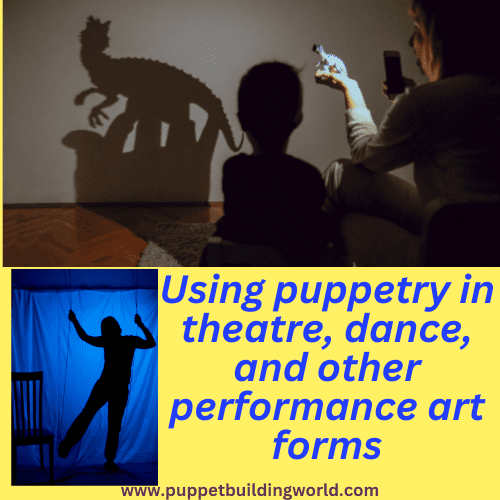Puppetry is a versatile and ancient art form that has been used in various forms of performance,
including theatre, dance, and other performance art forms. The use of puppetry in these medi-
ums allows for a unique form of storytelling and expression that can captivate audiences of all
ages.
In theatre, puppets have been used for centuries as a way to tell stories and convey messages.
From traditional hand puppets to more modern forms of puppetry such as marionettes and
shadow puppets, each type of puppet offers a unique way to tell a story. Hand puppets, for ex-
ample, are often used in children’s theatre and are a great way to introduce young audiences to
the world of puppetry. Marionettes, on the other hand, offer a more sophisticated form of pup-
petry that can be used to tell more complex stories. Shadow puppets, which are made from cut-
out figures that are placed in front of a light source, offer a unique form of storytelling that is
both mysterious and captivating.
In dance, puppetry can be used to create a visual spectacle that complements the movement of
the dancers. Puppets can be used to tell a story through movement, and can be manipulated by
dancers or puppeteers to create a dynamic and visually striking performance. One example is
the use of Bunraku puppets in traditional Japanese dance performances. These puppets, which
are operated by three puppeteers, are used to tell stories and convey emotion through move-
ment.
Puppetry can also be used in other forms of performance art such as street performance, where
puppets can be used to entertain and engage with audiences in a public setting. In this context,
puppets can be used to tell stories, convey messages, or simply provide a visual spectacle.
In conclusion, puppetry is a versatile and ancient art form that has been used in various forms of
performance, including theatre, dance, and other performance art forms. The use of puppetry in
these mediums allows for a unique form of storytelling and expression that can captivate audi-
ences of all ages. Puppetry offers a wide range of possibilities, whether it’s to tell a story, con-
vey a message, or create a visual spectacle, and it will continue to be an important part of
performance art in the future.
Integrating puppetry with other mediums such as music and visual art can enhance the overall performance and create a more immersive experience for audiences.
One way puppetry can be integrated with music is through the use of live music accompaniment during a puppetry performance. This can add an extra layer of emotion and atmosphere to the performance, as the music can be used to underscore the action on stage and enhance the mood of the story being told. In addition, puppets themselves can be designed to incorporate elements of music, such as strings or bells, to create a more dynamic and interactive performance.
Visual art can also be integrated with puppetry through the use of set design, lighting, and projections. For example, a puppet performance can be enhanced by incorporating projections of visual art onto the stage, creating a more immersive and dynamic performance. Set design can also be used to create a more visually striking performance, such as incorporating large-scale sculptures or other visual elements into the set. Lighting can also be used to create different moods and atmosphere throughout the performance.
Puppetry and technology can also be combined to create a more engaging and interactive performance. For example, puppets can be manipulated through the use of digital puppetry, where the puppeteer controls the movements of the puppet through the use of technology such as robotics or motion capture. This can create a more lifelike performance and offer new possibilities for storytelling and expression.
In conclusion, integrating puppetry with other mediums such as music and visual art can enhance the overall performance and create a more immersive experience for audiences. The combination of these mediums can create a more dynamic and visually striking performance, and new technologies can offer new possibilities for storytelling and expression.



